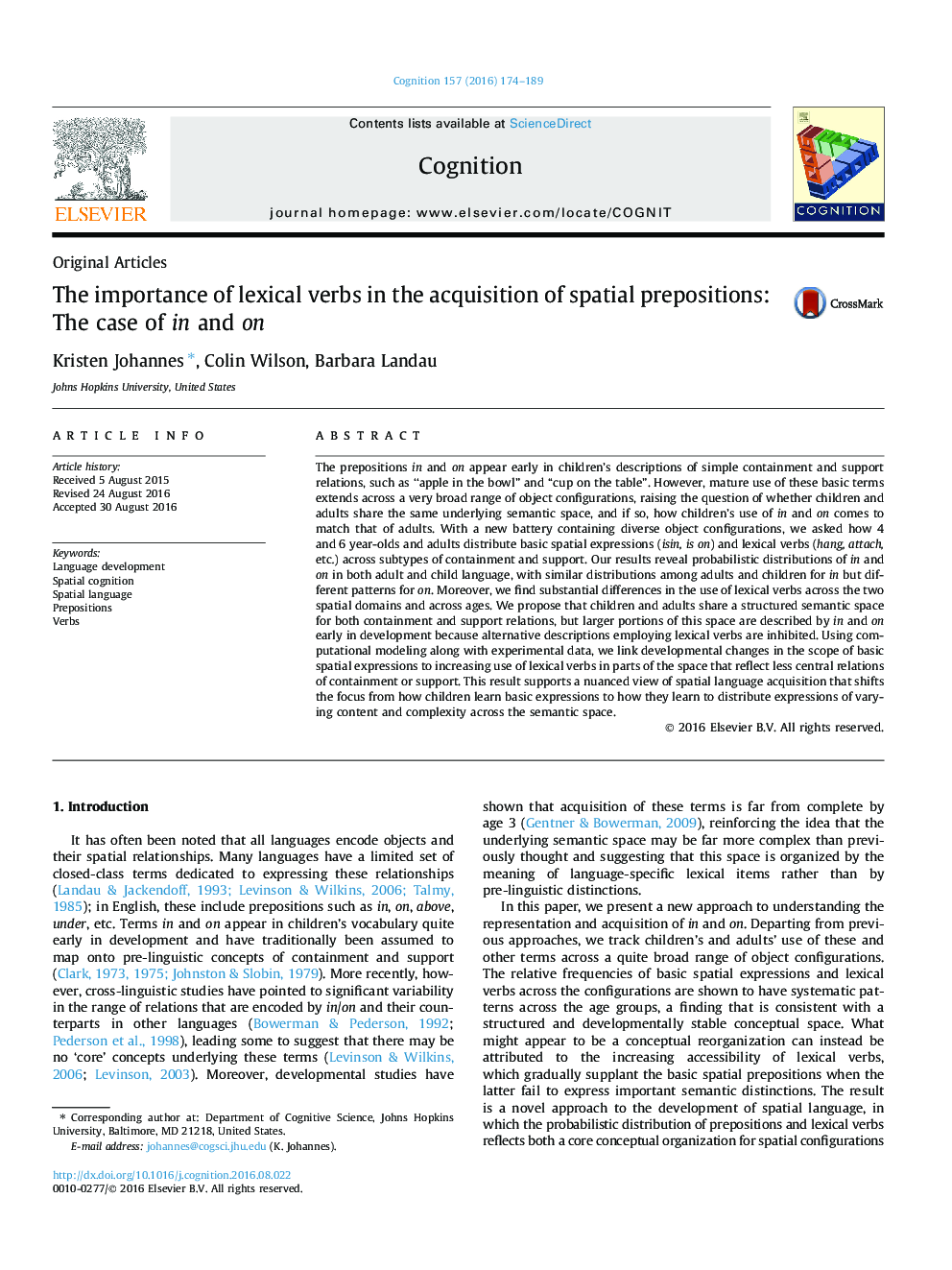| کد مقاله | کد نشریه | سال انتشار | مقاله انگلیسی | نسخه تمام متن |
|---|---|---|---|---|
| 7285757 | 1474110 | 2016 | 16 صفحه PDF | دانلود رایگان |
عنوان انگلیسی مقاله ISI
The importance of lexical verbs in the acquisition of spatial prepositions: The case of in and on
ترجمه فارسی عنوان
اهمیت افعال واژگان در دستیابی به مفاهیم فضایی: مورد در و در
دانلود مقاله + سفارش ترجمه
دانلود مقاله ISI انگلیسی
رایگان برای ایرانیان
کلمات کلیدی
توسعه زبان، شناخت فضایی، زبان فضایی، حروف اضافه، فعلها،
ترجمه چکیده
پیشنهادها در ابتدا در توصیف های کودکان از روابط ساده و مهاربندی، مانند سیب در کاسه ظاهر می شود؟ و یک فنجان روی میز؟ با این حال، استفاده بالغ از این اصطلاحات اساسی در طیف وسیعی از تنظیمات شیء گسترش می یابد و این مسئله را مطرح می کند که آیا کودکان و بزرگسالان یک فضای معنایی پایه را به اشتراک می گذارند و اگر چنین باشد، چگونه کودکان از آن استفاده می کنند تا در بزرگسالان . با یک باتری جدید که حاوی تنظیمات متنوعی است، از ما پرسیدیم که 4 و 6 ساله و بزرگسالان عبارات فضایی اساسی (ایزین، روشن است) و افعال واژگانی (آویزان، پیوستن و غیره) را در زیرمجموعه های نگهداری و پشتیبانی قرار می دهند. نتایج ما نشان می دهد توزیع احتمالاتی در داخل و اطراف در هر دو زبان بزرگسال و کودک، با توزیع مشابه در میان بزرگسالان و کودکان برای اما الگوهای مختلف برای. علاوه بر این، تفاوت های قابل توجهی در استفاده از افعال لغوی در دو حوزه فضایی و در سراسر سنین پیدا می کنیم. ما پیشنهاد می کنیم که کودکان و بزرگسالان یک فضای معنایی ساختاری برای روابط مهارتی و پشتیبانی دارند، اما بخش های بزرگ این فضا در ابتدا و در اوایل توسعه توصیف می شوند، زیرا توصیف های جایگزین با استفاده از افعال لغوی مهار می شوند. با استفاده از مدل سازی محاسباتی همراه با داده های تجربی، ما تغییرات توسعه را در محدوده عبارات فضایی اساسی پیوند می دهیم تا به افزایش استفاده از افعال واژگانی در قسمت هایی از فضا که منعکس کننده روابط مرکزی کمتر از حرمت یا حمایت باشد. این نتیجه پشتیبانی از یک دید کلی از درک زبان فضایی است که تمرکز خود را از اینکه چگونه کودکان عبارات پایه را به نحوه یادگیری توزیع عبارات محتوای متنوع و پیچیدگی در فضای معنایی آموزش می دهند، ترسیم می کند.
موضوعات مرتبط
علوم زیستی و بیوفناوری
علم عصب شناسی
علوم اعصاب شناختی
چکیده انگلیسی
The prepositions in and on appear early in children's descriptions of simple containment and support relations, such as “apple in the bowl” and “cup on the table”. However, mature use of these basic terms extends across a very broad range of object configurations, raising the question of whether children and adults share the same underlying semantic space, and if so, how children's use of in and on comes to match that of adults. With a new battery containing diverse object configurations, we asked how 4 and 6 year-olds and adults distribute basic spatial expressions (isin, is on) and lexical verbs (hang, attach, etc.) across subtypes of containment and support. Our results reveal probabilistic distributions of in and on in both adult and child language, with similar distributions among adults and children for in but different patterns for on. Moreover, we find substantial differences in the use of lexical verbs across the two spatial domains and across ages. We propose that children and adults share a structured semantic space for both containment and support relations, but larger portions of this space are described by in and on early in development because alternative descriptions employing lexical verbs are inhibited. Using computational modeling along with experimental data, we link developmental changes in the scope of basic spatial expressions to increasing use of lexical verbs in parts of the space that reflect less central relations of containment or support. This result supports a nuanced view of spatial language acquisition that shifts the focus from how children learn basic expressions to how they learn to distribute expressions of varying content and complexity across the semantic space.
ناشر
Database: Elsevier - ScienceDirect (ساینس دایرکت)
Journal: Cognition - Volume 157, December 2016, Pages 174-189
Journal: Cognition - Volume 157, December 2016, Pages 174-189
نویسندگان
Kristen Johannes, Colin Wilson, Barbara Landau,
